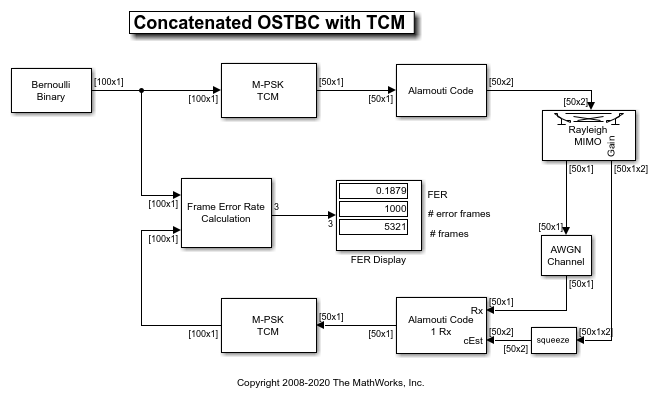MIMO Fading Channel
Filter input signal through MIMO multipath fading channel
Libraries:
Communications Toolbox /
Channels
Communications Toolbox /
MIMO
Description
The MIMO Fading Channel block filters an input signal using a multi-input/multi-output (MIMO) multipath fading channel. This block models both Rayleigh and Rician fading and employs the Kronecker model for modeling the spatial correlation between the links. For processing details, see the Algorithms section.
Signal Dimensions
The availability and dimensions of input and output port signals depends on:
The Antenna selection parameter setting on the Main tab
The Initial time source parameter setting on the Realization tab
The Output channel path gains selection on the Realization tab
| Antenna Selection Parameter | Signal Input (in) | Transmit Selection Input (Tx Sel) | Receive Selection Input (Rx Sel) | Initial Time Offset Input (Init Time) | Signal Output (Out1) | Optional Channel Gain Output (Gain) |
|---|---|---|---|---|---|---|
Off | NS-by-NT | N/A | N/A | nonnegative scalar | NS-by-NR | NS-by-NP-by-NT-by-NR |
Tx | NS-by-NST | 1-by-NT | N/A | NS-by-NR | ||
Rx | NS-by-NT | N/A | 1-by-NR | NS-by-NSR | ||
Tx and Rx | NS-by-NST | 1-by-NT | 1-by-NR | NS-by-NSR |
NS represents the number of samples in the input signal.
NT represents the number of transmit antennas, as determined by:
Transmit spatial correlation when you set Specify spatial correlation to
Separate Tx RxNumber of transmit antennas when you set Specify spatial correlation to
NoneorCombined
NR represents the number of receive antennas, as determined by:
Receive spatial correlation when you set Specify spatial correlation to
Separate Tx RxNumber of receive antennas when you set Specify spatial correlation to
NoneCombined spatial correlation and Number of transmit antennas when you set Specify spatial correlation to
Combined
NP represents the number of channel paths, as determined by the Discrete path delays (s) or Average path gains (dB).
NST represents the number of selected transmit antennas, as determined by the number of elements set to
1in the vector provided to the Tx Sel input port.NSR represents the number of selected receive antennas, as determined by the number of elements set to
1in the vector provided to the Rx Sel input port.
Examples
Ports
Input
Output
Parameters
Block Characteristics
Data Types |
|
Multidimensional Signals |
|
Variable-Size Signals |
|
Algorithms
References
[1] Oestges, C., and B. Clerckx. MIMO Wireless Communications: From Real-World Propagation to Space-Time Code Design. Academic Press, 2007.
[2] Correira, L. M. Mobile Broadband Multimedia Networks: Techniques, Models and Tools for 4G. Academic Press, 2006.
[3] Kermoal, J. P., L. Schumacher, K. I. Pedersen, P. E. Mogensen, and F. Frederiksen. "A stochastic MIMO radio channel model with experimental validation." IEEE Journal on Selected Areas of Communications. Vol. 20, Number 6, 2002, pp. 1211–1226.
[4] Jeruchim, M., P. Balaban, and K. S. Shanmugan. Simulation of Communication Systems. Second Edition. New York: Kluwer Academic/Plenum, 2000.
[5] Pätzold, Matthias, Cheng-Xiang Wang, and Bjorn Olav Hogstand. "Two New Sum-of-Sinusoids-Based Methods for the Efficient Generation of Multiple Uncorrelated Rayleigh Fading Waveforms." IEEE Transactions on Wireless Communications. Vol. 8, Number 6, 2009, pp. 3122–3131.
